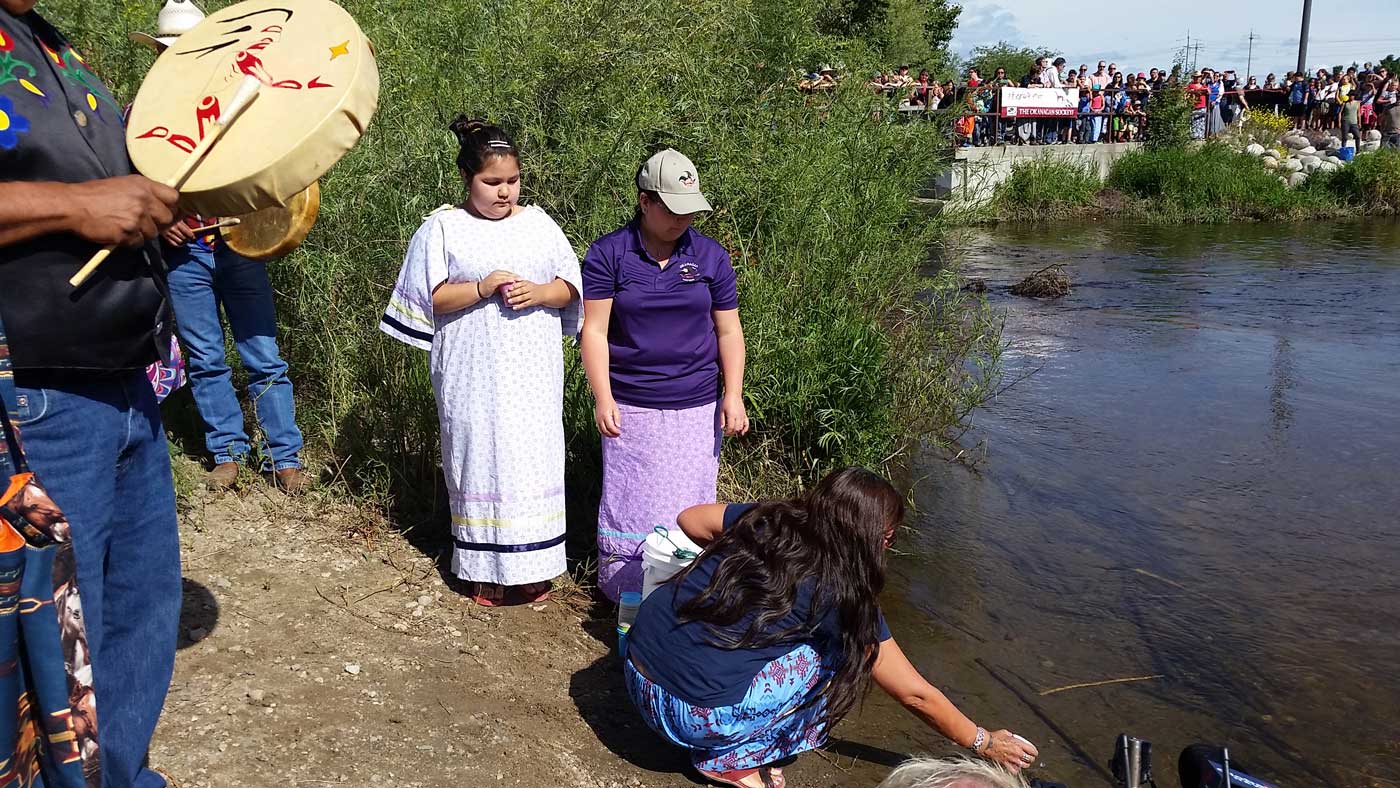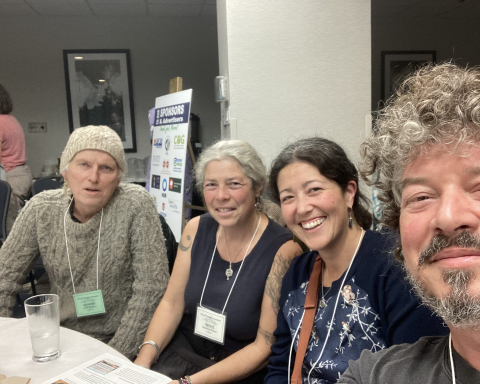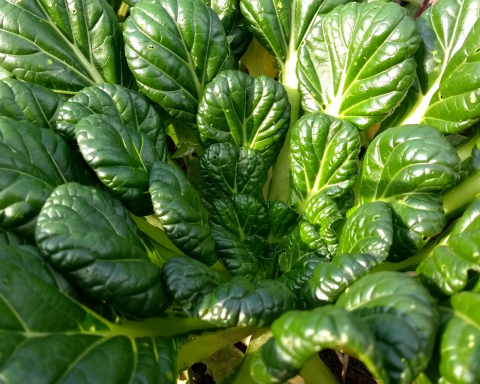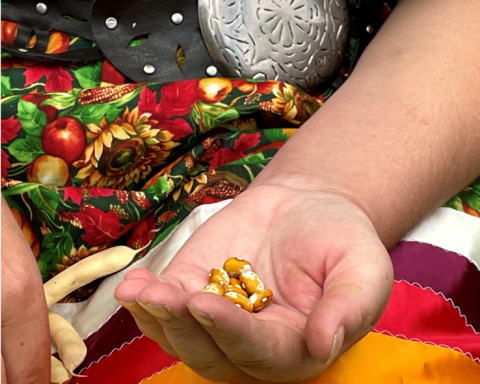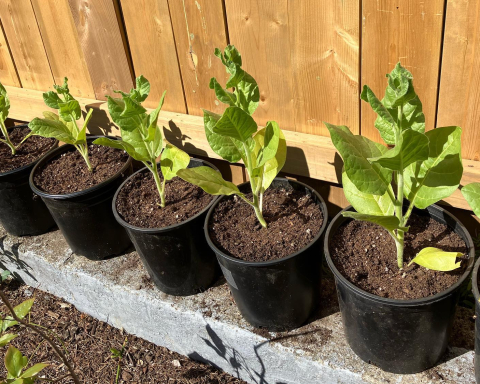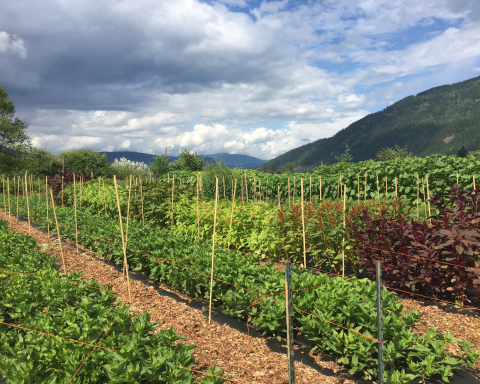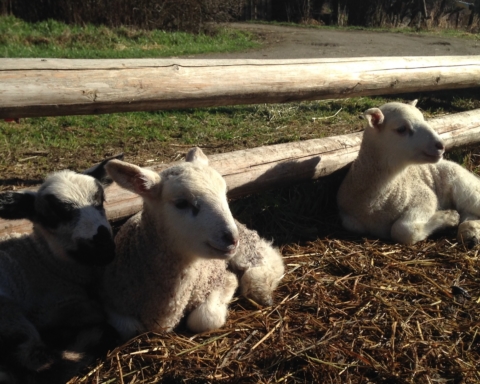Pauline Terbasket
We have, like the salmon, remained resilient, persistent and determined to be leaders in this work by feeding our peoples and lands.”
In January 2016, I had the opportunity to present to the Young Agrarians 3rd Okanagan Winter Mixer conference. I presented on our Syilx Salmon Recovery efforts and shared our successes and yet constant challenges respecting Indigenous Peoples and food security.
There are so many angles from which this story can be told, so I briefly and humbly shared mine, both personally and as an executive director of a Tribal Organization. It is our Chiefs’ office that is the primary driver of all our work “for the Peoples, lands, and resources”, collectively. I also want to acknowledge and respect the presentation that preceded mine by Nicholas Peterson, a Nlaka’pamux farmer of Nicola Valley Produce and leader of his community regarding the work his family is undertaking to grow their own foods so they are able to have a sustainable livelihood and future in the Nicola Valley Region.
Scwin, Nsyilxcen for Okanagan Sockeye salmon, have been a primary food mainstay of the Syilx Peoples and central to our cultural and trading traditions between Indigenous Peoples throughout the Interior of British Columbia and Northwest United States. These salmon annually migrate up the mighty Columbia River to spawn in the Okanagan watershed, where they are a cornerstone species, feeding humans, bears, birds, among others. After spawning, they turn brick red, decompose and further fertilize the river and lands, contributing to the terroir of the region.
Fraught with negative consequences rooted in our shared history of colonization and the reeling impacts of being alienated from our lands and resources, Indigenous Peoples have overall suffered immensely – as have their foods. In addition to this common past shared by all Indigenous Peoples, by the early thirties International Water Agreements had been launched leading to the building and expanse of hydro-electric developments on the Columbia River over our territories.
Over the course of the 20th century these developments garnered for the Columbia the dubious designation as one of the most dammed river systems in the world. Along with a host of other environmental disruptions and damages, these dams made it impossible for fish passage, devastating the annual Sockeye salmon runs to near extinction, and as such deeply undermining regional Indigenous food sovereignty and food systems.
The recovery of our salmon story mostly has been framed as a “negotiation of salmon mitigation and re-introduction to the Okanagan sub-basin” which has entailed over the course of the last 20 years a process of initiatives undertaken by the leadership of the Syilx Peoples in partnership with governments and numerous other agencies including projects that involve: research, modeling, brood stock assessment, habitat restoration, and water and temperature ow monitoring of this system, etc.
No one spoke outright of it being about “Indigenous food sovereignty and food security.” However, the underlying cause for our people was the ability to access and protect our traditional food source. Because of our plight, First Nations in Canada have legal protections to address injustices through the court system and now have legally entrenched rights for the use of our salmon for food, social and ceremonial purposes.
This is readily understood but not outwardly spoken because we know as Indigenous Peoples it is fundamental to our cultural, social, economic, and political way of being. It should not have to be explained. Our inherent knowing of our connection to our food systems is needed in addressing the underlying issues impacting Indigenous Peoples. Like the salmon, it is our responsibility to respond to our own needs for healthy, culturally adapted Indigenous foods. We have, like the salmon, remained resilient, persistent, and determined to be leaders in this work by feeding our peoples and lands.

Return of Salmon, Rebirth of Culture
While this work moved forward, so did the revitalization of our language, ceremonies, and customs:
kt cp’elk’ stim’ is an Nsyilxcen term that roughly translates as “to cause to come back.” With the guidance of our elders and sacred teachings, all seven Okanagan Nation’s member communities and the Colville Confederated Tribes have great conviction in their determination to have the Sockeye salmon return.
In 1996-1997 the Okanagan Nation Alliance (ONA), under the long standing leadership of the Chiefs and Councils of our member communities and the Colville Confederated Tribe Business Council (CCTBC), formally undertook their responsibilities and obligations to their lands, waters, and peoples to restore the Okanagan Sockeye salmon back to the Columbia River systems. In 2014, more than 600,000 Sockeye salmon returned, of which a fraction is carefully harvested to feed the people. Our leadership remains resolved to continue the work and commitment required to return salmon to the reaches of the Upper Columbia.
As Scwin journey back to the Okanagan to spawn we not only see the rejuvenation of a fish species, but the revitalization of Indigenous food sovereignty. A myriad of Syilx cultural practices, including the Salmon Feast, enable snxa?l’iwlem (honouring the sacredness of the river) while reinforcing strong cultural-spiritual ties between Syilx communities and the Sockeye salmon.
During fish harvest certain parts of the salmon are returned to the river of origin, with the backbones/fish heads distributed to the community for fish soup. Portions of fish are given as offerings to eagles and owls, again reinforcing strong reciprocal bonds within the broader ecosystem. As such, these salmon are central to a wide range of connections between generations, communities, humans & non-humans, terrestrial and aquatic species, and transboundary watersheds within Canadian and American sovereigns including Indigenous Tribes along the Columbia River systems.
This brief encapsulation and acknowledgement of centuries old cycles of nature, sacred worldview, intertwined with human interaction, pattern, intelligence, adaptability, and wisdom must continue if we are to sustain our life on this planet.
Last year our Scwin felt the direct impact of climate change. The 2015 salmon run incurred devastation with increased water temperature and lower water levels inhibiting the vast majority of Scwin returning to spawn. We know this will become more frequent as our world evolves. So as our Scwin have taught us, we must like never before not let these challenges deter us (like the dams) from our responsibilities to each other as neigh- bors, farmers, harvesters, sowers of seed, hunters, inno- vators, and relations.
Like the salmon we will persevere, be resilient, and be determined to overcome adversity.
Pauline Terbasket is a member of the Syilx Nation, and registered member of the Lower Similkameen Indian Band. She has led her community and her Nation as a council member of her local band and most recently as the Executive Director of the Okanagan Nation Alliance. A strong advocate for social change and food sovereignty, she has committed herself to tackling difficult issues confronting the prosperity and wellness of Indigenous People.


